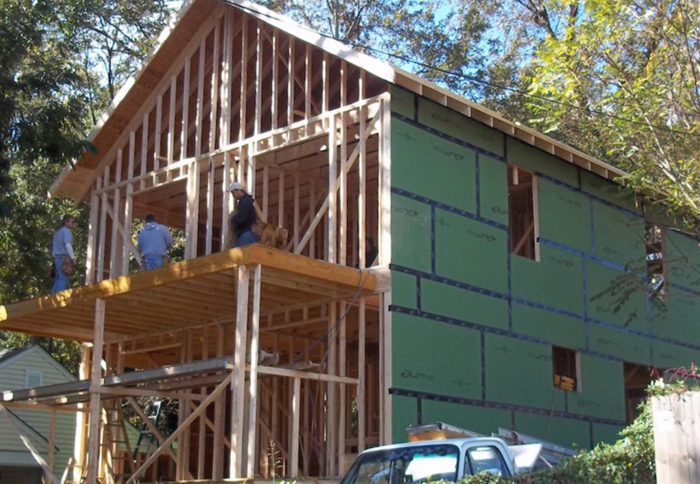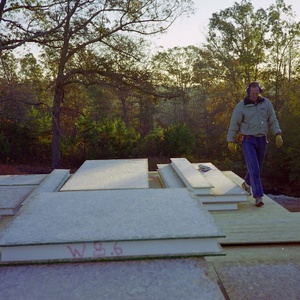
Image Credit: Energy Vanguard
You’re having your dream house built. You’re into the design phase, working with an architect or looking through collections of house plans. You’re doing your homework, trying to find out how to ensure you get a top quality house. And that’s when you run into all this stuff about building science, high performance homes, HVAC design, blower door testing, and the like. Now you’re hooked.
The problem you run into next is figuring out how to get that knowledge applied to your dream home. If you’re building the house yourself (as I did back in 2001), it’s on your shoulders. But most people aren’t owner-builders, instead hiring a professional home builder to bring their dreams to reality. If that’s you, keep reading. Hiring a builder is arguably your most important decision, so here are some questions you can ask prospective builders to find out how likely they are to do things the right way.
1. What is your view of airtight homes?
The builder’s answer to this question can tell you a lot. If they tell you, “A house needs to breathe,” you probably don’t need to waste any more time with them. Save your time to find a builder who appreciates the importance of an airtight building enclosure. You may not find a builder who gives you the ideal answer, but you want one who recognizes that greater airtightness is a good thing. If you can find one who’s had blower door tests even when they weren’t required, that’s a plus. And of course you want them to agree to have your house tested.
You can ask the builder about their previous airtightness test results. Here in Georgia, all new homes have to come in below 7 air changes per hour at a pressure difference of 50 Pascals (ACH50).
2. What is your preferred water resistant barrier (WRB)?
Controlling liquid water outside the house is the most important thing you can do to prevent failure. Yet, because water control failures often show up after the warranty period, some builders don’t care that much about them. There’s some pretty basic rules about controlling water, and although it’s not universally true, I find that builders who use the cheapest WRBs often seem to do the worst job controlling the water.
Perforated plastic housewrap is at the bottom of the list in my opinion. Housewrap can work well if it’s installed properly. It works better if it’s made of spun-bonded polyolefin, like Dupont’s Tyvek HomeWrap. Better yet is a non-house wrap WRB, like Huber’s Zip System sheathing, liquid-applied membranes (like Prosoco’s R Guard or Tremco’s Envirodry), or peel-and-stick membranes. [Disclosure: Huber is an advertiser in the Energy Vanguard Blog.]
3. How do you handle penetrations in the building enclosure after the WRB has been installed?
Controlling liquid water is critical. The WRB does that, but when it gets penetrated by wires, pipes, or dryer vents after it’s installed, it needs to be flashed properly. The best answer here would be if the builder tells you they plan ahead for every penetration and make sure each one has proper flashing ready to go before the hole is ever cut.
4. How do you ensure good installation quality of insulation?
If a prospective builder starts talking about insulation installation grades (I, II, or III), you’ve found one who knows something about this issue. Good answers here would include:
- We insist on Grade I installation quality for all insulation.
- We make sure all cavities are filled completely with as little compression as possible.
- We hire a third party inspector to make sure it’s done right.
5. How are the heating and air conditioning systems designed?
“We leave that up to the HVAC contractor” is not an acceptable answer. That doesn’t mean the HVAC contractor doesn’t do it, but the builder should know how they’re doing it. And the way it should be done is with room-by-room load calculations, proper equipment selection, and ducts designed for the right air flow to each room. Better would be for them to say they use a third-party HVAC designer, but you’re more likely to hear that from your architect than from a builder.
6. Do you have a preference for duct location?
Not so good if they answer that they always put them in the attic, and the attic is unvented. That’s a common practice outside of cold climates, but that doesn’t make it right. What you want to hear here is that they try to get the ducts into conditioned space. Sometimes that means moving the conditioned space boundary to include the attic or the crawl space.
7. What measures do you take for combustion safety?
Probe for any awareness of this issue. If they ask what you mean, ask what their stance is on natural draft water heaters and ventless fireplaces. You don’t want either of those things inside the conditioned space.
8. Do you normally install whole-house mechanical ventilation systems?
If you get this far into your list, that means you’re talking to a builder who believes in airtightness. That means they must believe in whole-house mechanical ventilation. The building code requires mechanical ventilation when the house tests at 5 air changes per hour or lower in the blower door test. If you’re getting a new house and want it built right, you definitely want it to be tighter than 5 ACH50, so you’ll need some type of mechanical ventilation. I recently wrote about some ways to do balanced ventilation, which is the best way to go.
9. Have you used third-party inspections or had your homes certified in voluntary programs like Energy Star?
If your prospective builder has experience with building to the standards of programs like Energy Star, LEED, or Passive House, you’ll probably have an easier time getting them to get the details right. That’s because these and similar programs have requirements that help ensure a house is built better. It’s not a guarantee, of course, but at least they’ll have some familiarity with checklists and good installation practices.
10. Would you be willing to have a design review with the critical trades?
Some builders don’t want you involved with the process at all. They just want to take the plans, build the house, and have you show up when it’s all done. Everyone’s busy now that the housing market has heated up again, and extra meetings take time away from other stuff.
But, a good builder realizes the importance of getting everyone on the same page and that it can save time down the road. Getting the architect, the builder, the HVAC contractor, the plumber, the electrician, and the insulation contractor together to go over the plans and goals for the house can prevent a lot of problems that might crop up otherwise. If your builder is willing to have such a meeting, it can make everything go smoother.
Builders can be like wild animals
If you live in an area with a lot of green building happening, you may have an easy time finding a builder who believes in building science. Even in those places, however, there are a lot of builders who think that high-quality building simply means high-quality finishes. What you’re looking for is that builder who is at least on the path to understanding that a high-quality house is high-quality to the core. But they may be a little shy about it.
Experienced home builders have developed ways of doing things that work for their businesses. Many are changing with the times, but they may still be a bit shy about jumping in with both feet. If you come at them with both barrels blasting them building science questions, you may scare them off. They’re like wild animals in that way. You have to approach them slowly because they spook easily.
Even a bad builder will know a lot more than you about the whole process of building a home. As long as they’re still in the running with you, show respect for that. Even when they’re out of the running, it’s best not to antagonize them. What you’re looking for is a builder you can work with, someone who is at least open to the idea of putting extra time and attention into the building enclosure and mechanical systems. The questions above should give you a good picture of which ones might be able to do a good job in building your dream home.
Allison Bailes of Decatur, Georgia, is a speaker, writer, building science consultant, and the author of the Energy Vanguard Blog. You can follow him on Twitter at @EnergyVanguard.
Weekly Newsletter
Get building science and energy efficiency advice, plus special offers, in your inbox.













6 Comments
First thing is first...
Nothing happens without a good set of plans and specifications. First, I would select the right Designer or Architect. Ask if the Designer or Architect has experience in high-performing houses. Any certifications? Referrals? Are you paying for a full set of detailed plans and specifications?
A few times a year, folks come to us with sets of plans designed by a hack, incompetent Designer or Architect, who charged them $1/sf and provided squat, or a $1,200 set bought from the internet, and then, they all want us to “green it”. Amaizing!!!
Just last week, one of my client Builders and I were looking for potential tear-down lots in Dallas, and we came across a well know Architect doing a project, and during our conversation she asked me to explain what thermal bridging and rainscreens are. REALLY???
Second, you probably should ask your prospective builders the same questions. Does the Builder has experience in high-performing houses? Certifications? Referrals?
No sense to ask a lot of questions if you don't have the right people in the first place.
A minor nit to pick...
"We make sure all cavities are filled completely with as little compression as possible."
Compression of batts is fine (resulting in a higher R/inch due to the higher density) as long as the cavity is completely filled. This comes up WAY more often than it should when discussing installing shredded batt against backer rod in window installations, where some installers take pains to not compress the fiberglass too much. In that application t's damned near impossible to compress the fiberglass "too much", without using a hammer!
Compress it as much as you like, as long as the compression doesn't result in voids, and it's still a complete cavity fill.
Concern by installers about "...as little compression as possible..." too often yields hard to inspect voids where the exterior sheathing meets the framing. In order to eliminate those voids batts NEED to be tucked in firmly at corners and along the framing, then tugged out gently until it's just proud of the stud edges, for a compression fit when the wallboard goes up.
Second thing
After Armando's point about an at least half-way decent plan, you could boil it down to just one simple question:
Are you thoroughly aware of what the 2015 IECC requires of you when building my dream home in this climate zone?
If you get a blank stare, no need to go through 1-10.
Response to Armando Cobo
All good points, Armando. A knowledgeable and skilled architect and a solid design are definitely the place to start.
Response to Dana Dorsett
Yes, you're absolutely right, Dana. I rarely see cases where compression doesn't go with voids, though. Most of the homes I see use spray foam around windows, not backer rod and fiberglass. In wall cavities, the only time I see this is with the 1/2" of compression you get with R-19 batts in a 2x6 wall.
Response to Todd Eidson
That's a good question, Todd, but unscrupulous builders will just bluff their way through it. Also, it wouldn't apply as stated in all locations because not everyone is on the 2015 IECC. Here in Georgia, for example, we're just now going through the process of updated from 2009 IECC to 2015, and it won't go into effect until next year. Plus, we're weakening it by not going all the way to 3 ACH50 and still allowing R-13 walls.
The questions I posed above are mostly open-ended and require the builder to reveal his or her philosophy about building as well as how much they know about the principles behind good building.
Log in or create an account to post a comment.
Sign up Log in